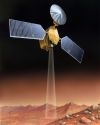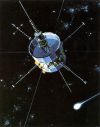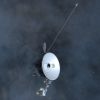Emily Lakdawalla • Feb 24, 2010
What's up in the solar system in March 2010
I am getting an early start on this month's "What's Up" post because March is going to start with a bang. Cassini has super-close flybys of Rhea and Helene on March 2 and 3 at altitudes of 100 and 1,803 kilometers, respectively. At the same time, Mars Express will have its closest ever flyby of Phobos, at an altitude of only 50 kilometers, on March 3; this one is preceded and followed by a total of eleven other flybys at altitudes up to about 1,300 kilometers.
While all of this is going on, so is the Lunar and Planetary Science Conference in Houston. And I am going!! This will be the first professional meeting I have attended in person since before I went on doctor-ordered bed rest to make sure the baby didn't arrive too early. Sanaya is 10 months old now -- still a baby, but able to be left in the care of grandparents for a couple of days. So, watch out, Houston, here I come! I'll have much more to write about LPSC this week and next, as I scramble to cover all of the other stuff that's happening around the solar system.
So, without further ado, here are the details on what to expect in March:
In the inner solar system:
 The MESSENGER spacecraft is cruising along; this month it will fly into its final year of cruising. Mercury orbit insertion is planned for March 18, 2011. They released a nice color composite last month that showcases how they are improving their processing of color image data to elucidate the differences among different types of surface rocks.
The MESSENGER spacecraft is cruising along; this month it will fly into its final year of cruising. Mercury orbit insertion is planned for March 18, 2011. They released a nice color composite last month that showcases how they are improving their processing of color image data to elucidate the differences among different types of surface rocks.
 Venus Express remains healthy (as of November 14) in orbit at Venus. Its current mission extension runs through 2012.
Venus Express remains healthy (as of November 14) in orbit at Venus. Its current mission extension runs through 2012.
 Lunar Reconnaissance Orbiter is busily mapping the Moon from its science orbit. The Lunar Recon Orbiter Camera image gallery site is down just now but they have been steadily releasing cool captioned images all month.
Lunar Reconnaissance Orbiter is busily mapping the Moon from its science orbit. The Lunar Recon Orbiter Camera image gallery site is down just now but they have been steadily releasing cool captioned images all month.
At the Sun:
 Images from the ESA/NASA SOHO mission show that the formerly quiescent Sun has really burst into action this month. As always, SOHO's near-real-time data and images are available here.
Images from the ESA/NASA SOHO mission show that the formerly quiescent Sun has really burst into action this month. As always, SOHO's near-real-time data and images are available here.
 The twin STEREO spacecraft now provide nearly full longitude coverage on the Sun, as STEREO-A is 65 degrees ahead of Earth and STEREO-B is 71 degrees behind. That leaves only about 45 degrees of longitude not visible from any spacecraft. The daily STEREO image viewer shows several groups of sunspots at high northern and southern latitudes.
The twin STEREO spacecraft now provide nearly full longitude coverage on the Sun, as STEREO-A is 65 degrees ahead of Earth and STEREO-B is 71 degrees behind. That leaves only about 45 degrees of longitude not visible from any spacecraft. The daily STEREO image viewer shows several groups of sunspots at high northern and southern latitudes.
On to Mars:
 This month is a really exciting one for ESA's Mars Express. In February and March, Mars Express is focusing on Phobos, with 12 flybys of the moon; the closest occurs on March 3 at an altitude of only 50 kilometers. They have a special blog focusing on the Phobos campaign, which lasts six weeks in total, from February 16 to March 26. During the closest flyby, they'll be doing radio tracking to study the internal density structure of the moon. Most of the best images will come from flybys after the March 3 one; at that time they'll image the proposed Phobos-Grunt landing site. I'll keep you all posted with the latest from Phobos! Meanwhile, the Mars Webcam has been returning lots and lots of frame-filling lower-altitude images of Mars recently. Even better, the Mars Webcam team has incorporated some of the image processing techniques developed by me and the other folks at unmannedspaceflight.com into their publishing workflow, with the result that the images posted to their website now look in proper Martian color.
This month is a really exciting one for ESA's Mars Express. In February and March, Mars Express is focusing on Phobos, with 12 flybys of the moon; the closest occurs on March 3 at an altitude of only 50 kilometers. They have a special blog focusing on the Phobos campaign, which lasts six weeks in total, from February 16 to March 26. During the closest flyby, they'll be doing radio tracking to study the internal density structure of the moon. Most of the best images will come from flybys after the March 3 one; at that time they'll image the proposed Phobos-Grunt landing site. I'll keep you all posted with the latest from Phobos! Meanwhile, the Mars Webcam has been returning lots and lots of frame-filling lower-altitude images of Mars recently. Even better, the Mars Webcam team has incorporated some of the image processing techniques developed by me and the other folks at unmannedspaceflight.com into their publishing workflow, with the result that the images posted to their website now look in proper Martian color.
 Out at Mars, it's mid southern hemisphere autumn (Ls 56°). Today it is Mars Exploration Rover Spirit sol 2184 and Opportunity sol 2163. Spirit's solar panels are currently putting out about 160 Watt-hours, which is enough to keep her batteries charged; she'll be fine as long as she can produce at least 140. Opportunity has spent a few weeks at Concepcion crater and is now driving clockwise around it to get a slightly different point of view; I expect to see her depart for points south before too long. Here is Eduardo Tesheiner's latest route map and Google Earth kml file for Opportunity. The predicted path for Opportunity will take her about 700 meters slightly west of due south to get to a cool looking doublet crater (looks like the impactor broke into two big pieces before it hit).
Out at Mars, it's mid southern hemisphere autumn (Ls 56°). Today it is Mars Exploration Rover Spirit sol 2184 and Opportunity sol 2163. Spirit's solar panels are currently putting out about 160 Watt-hours, which is enough to keep her batteries charged; she'll be fine as long as she can produce at least 140. Opportunity has spent a few weeks at Concepcion crater and is now driving clockwise around it to get a slightly different point of view; I expect to see her depart for points south before too long. Here is Eduardo Tesheiner's latest route map and Google Earth kml file for Opportunity. The predicted path for Opportunity will take her about 700 meters slightly west of due south to get to a cool looking doublet crater (looks like the impactor broke into two big pieces before it hit).
 Mars Reconnaissance Orbiter is humming along in normal science operations. The latest MARCI weather reports detail local dust storm activity and lots of water ice clouds but, in spite of all that, generally pretty clear skies for both solar-powered rovers. The latest captioned image releases from HiRISE include one that shows how they're continuing to follow up on the new impact craters first spotted by Mars Global Surveyor. Most, they say, show little change from year to year, but they did find one spot where there has been tremendous year-to-year change (look at the detail image to see comparisons between images of the cluster taken in March 2007, February 2008, and January 2010).
Mars Reconnaissance Orbiter is humming along in normal science operations. The latest MARCI weather reports detail local dust storm activity and lots of water ice clouds but, in spite of all that, generally pretty clear skies for both solar-powered rovers. The latest captioned image releases from HiRISE include one that shows how they're continuing to follow up on the new impact craters first spotted by Mars Global Surveyor. Most, they say, show little change from year to year, but they did find one spot where there has been tremendous year-to-year change (look at the detail image to see comparisons between images of the cluster taken in March 2007, February 2008, and January 2010).
 NASA's Mars Odyssey remains the longest-lived spacecraft in orbit at Mars. You can see the latest from its THEMIS instrument here. And hey, I just noticed that they redesigned their website; their homepage now displays thumbnails of many many more images at once, a welcome change. Odyssey is also still listening for signals from the Phoenix lander; nothing so far.
NASA's Mars Odyssey remains the longest-lived spacecraft in orbit at Mars. You can see the latest from its THEMIS instrument here. And hey, I just noticed that they redesigned their website; their homepage now displays thumbnails of many many more images at once, a welcome change. Odyssey is also still listening for signals from the Phoenix lander; nothing so far.
Exploring Saturn:
 As I predicted in last month's "what's up" article, NASA announced the extension of the Cassini mission until late 2017, doubling its duration. Hooray! It's now in rev 127, which will be an eventful one: there will be very close, targeted flybys of Rhea (at 100 kilometers altitude) and Dione's leading co-orbital moon Helene (at 1803 kilometers) on March 2 and 3. There are lots of details on the plans for the Rhea and Helene flybys in the Rev 127 Looking Ahead article. After that, things will be fairly quiet until the next targeted flyby of Titan on April 5, which will be followed closely by a 500-kilometer flyby of Dione. All these icy moon flybys are possible because Cassini's orbit currently has it in Saturn's ring plane, where it'll stay until June.
As I predicted in last month's "what's up" article, NASA announced the extension of the Cassini mission until late 2017, doubling its duration. Hooray! It's now in rev 127, which will be an eventful one: there will be very close, targeted flybys of Rhea (at 100 kilometers altitude) and Dione's leading co-orbital moon Helene (at 1803 kilometers) on March 2 and 3. There are lots of details on the plans for the Rhea and Helene flybys in the Rev 127 Looking Ahead article. After that, things will be fairly quiet until the next targeted flyby of Titan on April 5, which will be followed closely by a 500-kilometer flyby of Dione. All these icy moon flybys are possible because Cassini's orbit currently has it in Saturn's ring plane, where it'll stay until June.
Quietly cruising:
 ESA's Rosetta is cruising along toward its May 2014 rendezvous with comet Churyumov-Gerasimenko. It went into safe mode on January 1 but was quickly recovered.
ESA's Rosetta is cruising along toward its May 2014 rendezvous with comet Churyumov-Gerasimenko. It went into safe mode on January 1 but was quickly recovered.
 The International Cometary Explorer remains on course for a return visit to Earth in 2014. When it does, ICE can be returned to a Sun-Earth L1 halo orbit, or can use multiple Earth swingbys to encounter Comet Wirtanen during its near-Earth apparition in December 2018.
The International Cometary Explorer remains on course for a return visit to Earth in 2014. When it does, ICE can be returned to a Sun-Earth L1 halo orbit, or can use multiple Earth swingbys to encounter Comet Wirtanen during its near-Earth apparition in December 2018.
![]() NASA's Dawn is now in the asteroid belt for good, and is steadily thrusting with its ion engines, patiently propelling itself toward a rendezvous with Vesta in July 2011.
NASA's Dawn is now in the asteroid belt for good, and is steadily thrusting with its ion engines, patiently propelling itself toward a rendezvous with Vesta in July 2011.
 NASA's Deep Impact is cruising toward its November flyby of comet 103P/Hartley 2.
NASA's Deep Impact is cruising toward its November flyby of comet 103P/Hartley 2.
 Last month NASA's Stardust performed its all-important trajectory correction maneuver to target it for its flyby of comet Tempel 1. Closest approach will happen at 8:42 p.m. PST on February 14, 2011, or 04:42 February 15 UTC.
Last month NASA's Stardust performed its all-important trajectory correction maneuver to target it for its flyby of comet Tempel 1. Closest approach will happen at 8:42 p.m. PST on February 14, 2011, or 04:42 February 15 UTC.
 Hayabusa is still on track to return to Earth later this year; the latest status report indicates all is well, and that the steady thrusting of the ion engines has brought Hayabusa's predicted Earth close-approach point to under half a million kilometers.
Hayabusa is still on track to return to Earth later this year; the latest status report indicates all is well, and that the steady thrusting of the ion engines has brought Hayabusa's predicted Earth close-approach point to under half a million kilometers.
 NASA's New Horizons has 15.92 AU to go to reach Pluto. As of tomorrow it'll have covered half of the total cruise distance to Pluto. It's still on course for a January to July 2015 encounter with the Pluto and Charon system. The spacecraft is presently in the middle of a long hibernation period with only weekly beacon and monthly telemetry reports until it wakes up again in May.
NASA's New Horizons has 15.92 AU to go to reach Pluto. As of tomorrow it'll have covered half of the total cruise distance to Pluto. It's still on course for a January to July 2015 encounter with the Pluto and Charon system. The spacecraft is presently in the middle of a long hibernation period with only weekly beacon and monthly telemetry reports until it wakes up again in May.
And beyond:
 Finally, NASA's Voyager 1 and 2 spacecraft were still responding to commands from Earth as of December 25. Both have now crossed the "termination shock," where the solar wind slows down as it impinges upon the interstellar medium.
Finally, NASA's Voyager 1 and 2 spacecraft were still responding to commands from Earth as of December 25. Both have now crossed the "termination shock," where the solar wind slows down as it impinges upon the interstellar medium.
Some other milestones to take note of this month, taken mostly from JPL's Space Calendar:
- March 14: (most of) United States (but not Europe) sets clocks ahead 1 hour.
- March 21: Saturn is at opposition.
- March 28: Europe sets clocks ahead 1 hour.
Let’s Go Beyond The Horizon
Every success in space exploration is the result of the community of space enthusiasts, like you, who believe it is important. You can help usher in the next great era of space exploration with your gift today.
Donate Today

 Explore Worlds
Explore Worlds Find Life
Find Life Defend Earth
Defend Earth

